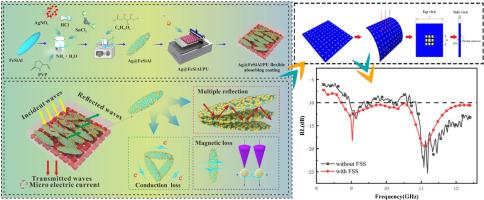Influence of reducing agent concentration on properties of flexible microwave absorbing coating containing silver coated FeSiAl powders
IF 8.2
2区 材料科学
Q1 MATERIALS SCIENCE, MULTIDISCIPLINARY
引用次数: 0
Abstract
In this study, silver coated FeSiAl powders (Ag@FeSiAl) with various reducing agent concentrations were synthesized. Then the powders were incorporated with polyurethane (PU) to prepare a flexible microwave absorbing coating with frequency-selective surface (FSS) structure. TEM analysis revealed that silver nanoparticles were uniformly distributed within the FeSiAl matrix with high crystallinity. SEM demonstrated that as the reducing agent concentration increased, the amount of silver particles on the powders surface grew, then agglomeration and free silver emerged at higher concentrations. XPS spectra confirmed the metallic state of silver and carbon functionalization, linking elemental composition to structural characteristics. Particle size distribution initially widened and then narrowed with increasing concentrations, leading to an initial increase and subsequent decrease in average particle size. Coating thickness and reducing agent concentration were shown to affect absorption properties significantly. At 8 g/L, the coating achieved a maximum reflection loss of −40.90 dB, while the effective absorption bandwidth reached 2.91 GHz at 10 g/L. Excessively high concentrations caused poor impedance matching as well as reducing performance. FSS design helps to enhance the absorption performance, achieving a 3.69 GHz bandwidth with a absorbing bandwidth of 8.71–12.4 GHz. Electric and magnetic field distributions provided insight into the interplay of FSS structural parameters, illustrating their impact on absorption behavior.

还原剂浓度对含银fesal粉末柔性微波吸收涂层性能的影响
本研究合成了不同还原剂浓度的银包覆fesal粉末(Ag@FeSiAl)。然后将粉末与聚氨酯(PU)混合,制备具有频率选择表面结构的柔性微波吸收涂层。TEM分析表明,纳米银颗粒均匀分布在高结晶度的fesal基体中。SEM结果表明,随着还原剂浓度的增加,粉体表面银颗粒数量增加,在较高浓度下出现团聚和游离银。XPS光谱证实了银和碳功能化的金属状态,将元素组成与结构特征联系起来。随着浓度的增加,粒径分布先变宽后变窄,导致平均粒径先增大后减小。涂层厚度和还原剂浓度对吸附性能有显著影响。在8 g/L时,涂层的最大反射损耗为- 40.90 dB,而在10 g/L时,有效吸收带宽达到2.91 GHz。过高的浓度会导致阻抗匹配不良,并降低性能。FSS设计有助于提高吸收性能,实现3.69 GHz带宽,吸收带宽为8.71-12.4 GHz。电场和磁场分布揭示了FSS结构参数的相互作用,说明了它们对吸收行为的影响。
本文章由计算机程序翻译,如有差异,请以英文原文为准。
求助全文
约1分钟内获得全文
求助全文
来源期刊

Materials Today Nano
Multiple-
CiteScore
11.30
自引率
3.90%
发文量
130
审稿时长
31 days
期刊介绍:
Materials Today Nano is a multidisciplinary journal dedicated to nanoscience and nanotechnology. The journal aims to showcase the latest advances in nanoscience and provide a platform for discussing new concepts and applications. With rigorous peer review, rapid decisions, and high visibility, Materials Today Nano offers authors the opportunity to publish comprehensive articles, short communications, and reviews on a wide range of topics in nanoscience. The editors welcome comprehensive articles, short communications and reviews on topics including but not limited to:
Nanoscale synthesis and assembly
Nanoscale characterization
Nanoscale fabrication
Nanoelectronics and molecular electronics
Nanomedicine
Nanomechanics
Nanosensors
Nanophotonics
Nanocomposites
 求助内容:
求助内容: 应助结果提醒方式:
应助结果提醒方式:


